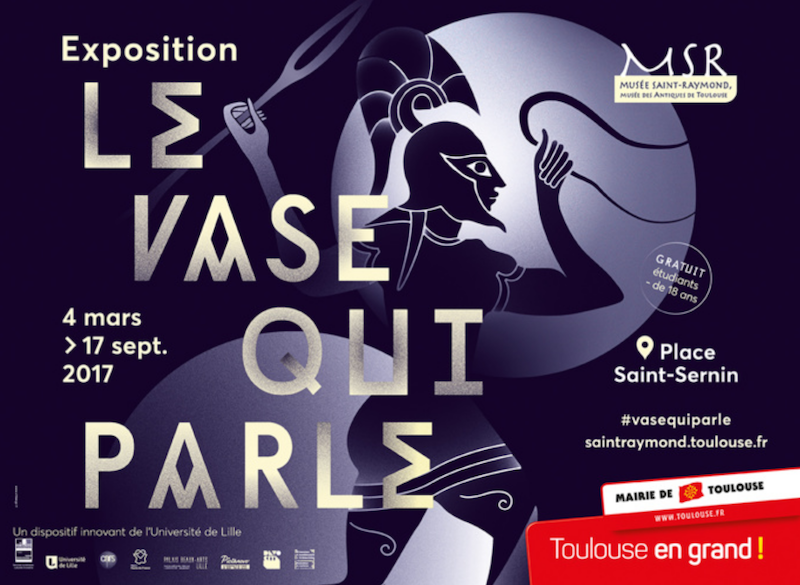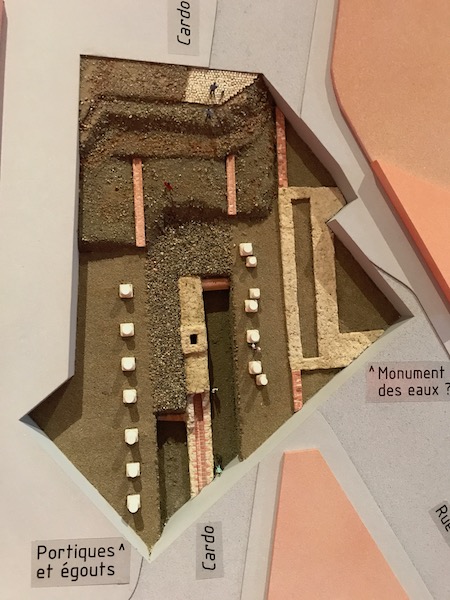Our Blog - Museum Saint-Raymond (June 2017)
Musée Saint-Raymond is the archeological museum of Toulouse, which opened in 1892. The site originally was a necropolis, but has gone through a set of purposes, including a hospital for the poor, a prison, a student residence, and a military barracks before finally becoming a museum in 1891. It is really an interesting little museum that exhibits archaeological collections from protohistory to the early Middle Ages, mainly from the Celtic, Roman and early Christian periods, much from the Toulouse region. I'll talk more about the actual building later when I get to the Necropolis.
The museum, which was originally meant to off-load some small antiquities from the Musee des Augustins that could not be displayed there, was opened in April 1892. In 1949, under the direction of Robert Mesuret, it became the archeological museum of Toulouse and began showing collections of Antiquity and the Early Middle Ages of the city of Toulouse.
We started out with a special exhibition that is here through September. The nice thing was that while it is normally free for students, it was actually free for us also today! It is entitled "Le Vase Qui Parle" or "The Vase That Speaks". If the Greek vases could speak, what stories would they tell us? Stories of gods, goddesses, heroes, and warriors ... The exhibit has a set of Greek vases and attempts to explain what story each tells. While we didn't take a picture of it, the cornerstone of the exhibit is actually a large reproduction of a rare Greek ceramic vase dating from the 6th century BC, which is from the Palais des Beaux-Arts in Lille. The original vase, which was also on display, is actually not often even visible, so this was a special thing.

The old man with a white beard leans on a stick, which serves both as a cane and as a symbol indicating his status as a citizen. His hand it outstretched towards to the side of the vase, which shows a warrior. This could be a gesture of farewell to the warrior as he departs for war. The old man may be remembering when he, himself, left for war as a young man and came back alive from his fight.


Many Greek vases have decorations that depict either war (of some kind), or female beauty. Here is the latter, where you have a young woman wearing a toga/dress, peering into a mirror. Women and beauty always seem to figure into the misfortunes of Greek gods and men .. remember the Trojan War was triggered by women and beauty.

The main part of the museum starts with a really nice presentation that shows the early Gaul sites around Vieille-Toulouse (south of town), up to the Roman settlement of Tools (Toulouse). Starting from about the 3rd century BC, there was a settlement South of the current city of Toulouse in what is called Vieille-Toulouse (literally, Old Toulouse). The original Gaul settlement was active with workshops of craftsmen and was involved in importing wine from Italy. The Romans settled there in the 1st century BC and expanded the trade throughout Europe. It was abandoned in the 1st century AD when the new Roman city was created in what is today downtown Toulouse. In this 1st century BC Roman city, they had roof tiles very similar to what is today seen in Toulouse, although slightly different. The roofs here are almost all covered with the red Mediterranean tiles although they are completely covered with the curved tiles, whereas these old 1st century BC roofs were made up of flat files placed side-by-side, with the curved tiles only covering the edges.

This is a fragment with an inscription which is dated to 47 BC, making it one of the oldest Latin inscriptions to be found in France (Gaul). The dating is thanks to a mention of the consul Quintus Fufius, and it speaks about the construction of a temple which was financed by people of both Italian and Greek origin.

This was an interesting little model. When the city of Toulouse started excavations to build the Carmes metro station, in the South part of the Centre Ville, they found a north-south oriented Roman road (called a "card"). It is more than 20 meters wide and was bordered by gutters and covered galleries. Under this Roman road, they also found a sewer with square mouths.

This is a model of the Grand North Porte, or Great North Gate of the city. It dates back to the 1st century AD when the Roman city moved from the previous site at Vieille-Toulouse up the Garonne river to where Toulouse sits today. This North gate was situated at the current Place du Capitole, and marks the Northern entrance to the town. The second picture shows how this gate and the city wall (shown here) fits into the current Place du Capitole (shown in grey).


This is a huge mosaic which was discovered in 1833. The first picture is a drawing of the mosaic pieces that were found and then you can see the pieces (with holes where there are missing pieces).



This mosaic is called Nymphogenes (meaning son of a nymph), and was also discovered in 1833. The fragment represents a marine divinity holding a long baton, most likely a trident, and blowing into a conch shell. This is thought to be the earliest known art/mosaic attributed to a sea god.

This is one of two pieces of a relief that was found while excavating for the underground parking garage in the Esquirol area (rue de Metz) in 1992.

This life-size statue foot was found near the Cathedral de Saint-Etienne and dates back to the 1st or 2nd century. There is only part of the base and the right foot of a life-sized statue. The toes show amazing detail, with the toe nails and lines in the skin. Whomever this was, they wore richly decorated sandals.

The next floor was based around a complex called Chiragan, a hamlet which was the site of a large Roman villa located along the Garonne river. Hundreds of different types of marble facings were found, which indicate the wealth of the owners of the villa. This is the only place in France where such an exceptional set of sculptures was discovered.
This first one is a marble head (portrait) of a small child. The identity of the child is not known, but the assumption is that it is the son of a high-ranking official of the Empire. It has a full head of hair with lots of detail.

Another unknown portrait in marble, done between 140 and 150 under the Roman Empire. We know that it is a mare woman with a refined hairstyle, with a chignon created with 5 rows of wound braids.

This is the head of Lucius Verus, who was the co-emperor with Marcus Aurelius from 161 to 169 (it was Marcus Aurelius who requested that Lucius have equal powers as Lucius was his adoptive brother through a bunch of really bizarre adoptions) and it was the first time that Rome was ruled by two emperors. They ruled together until 169 AD after falling ill after returning to Rome with Marcus Aurelius after a war on the Danube against the Marcomanni, who had invaded Roman territory.

I follow up Lucius Verus with a bust of an older Marcus Aurelius. This was created to commemorate the 10th year of the reign of Marcus Aurelius in 171 AD. In the movie Gladiator, with Russell Crowe, part of the storyline is that Marcus Aurelius was assassinated because he intended to pass down power to his adopted son, a Roman general (Crowe), instead of his biological son, Commodus. A bit of trivia ... the Wikipedia entry for Marcus Aurelius actually has this bust (from the Musee Saint-Raymond in Toulouse) pictured.

In the Roman era, mosaics decorated the floors of thermal baths, reception halls, dining rooms, and bedrooms. Two large mosaics were found and removed from Chirgan.


We headed down to the basement for the Necropolis. The building itself was originally a Christian necropolis dating from the 4th century, located close to the Basilica of Saint-Sernin (which is next door to the museum). Here is the really interesting part ... Between 1994 and 1996, archaeological excavations were undertaken to uncover the necropolis of Saint-Sernin, near the tomb of the martyred saint Saturnin, and his burials dating to the 4th century. A lime kiln dating from the 5th or 6th century was also discovered, and with about a hundred sarcophagus's (or is it sarcophagi?). Its purpose was to produce lime, which was then used to create lime mortar. Lime mortar is extremely resistant and effective and came into use during Early Antiquity for various things, including construction of buildings, creation of architectural elements, and sarcophagus decorations. At the time of its discovery, the oven was full of remains of sarcophaguses and architectural elements.


This is a small christian sarcophagus dating from the 4th century. Around it are various reliefs, including Adam and Eve, Daniel in the lions den, Abraham sacrificing his son Isaac.


I mentioned earlier that there was a hospital on this site long ago. During the excavations, the old walls of the hospital were found and you can see a portion of the original wall, along with a picture that shows the orientation of that wall to the rest of the building.


